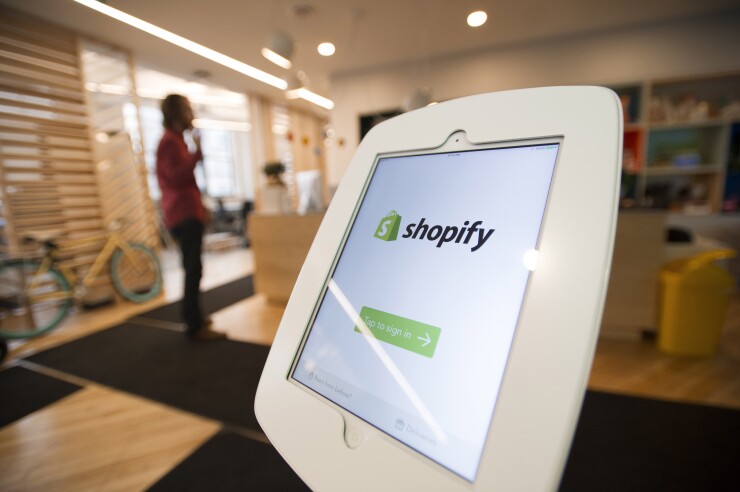
Shopify’s name is practically synonymous with digital commerce – which is why it’s well suited to follow tech-savvy consumers back to stores as more people return to in-person shopping.
Shopify launched POS Go this week, a mobile device that extends Shopify’s mobile point of sale to add more payment data and links to merchant services as the company aims to capitalize on increased in-store sales and growth in its payment business.
More payment processors are adding multi-channel shopping and data analytics as payment acceptance technology becomes less of a competitive differentiator than intelligence that can be used for marketing or to manage supply chains and inventory.

Kevin Van Paassen/Bloomberg
“The offering isn’t just about supporting payments, it also needs to be integrated with all the essential services of running a business,” said Richard Crone, a payment advisor.
Shopify’s POS Go, which builds on point of sale hardware that it started offering in 2017 includes a barcode scanner that allows checkout to take place anywhere in a store. It also stores product information, customer data, and purchase history.
Merchants can build digital shopping carts in stores and email consumers to make purchases for products that can be shipped. Options for accepting payments include tap, swipe, and chip cards through a card reader. Businesses can also sell, view analytics, and inventory across multiple channels on POS Go.
Shopify is also an early adopter of Apple’s Tap to Pay, which allows merchants to use personal iPhones to accept payments. Other early adopters include: Stripe and Adyen. Apple does not provide payment processing for Tap to Pay, which means the partners must have access to their own technology to combine iPhone payments with other merchant services.
“Shopify mobilizes all paths,” Crone says. Adding the bundle of payment and commerce services through POS Go and the partnership with Apple gives Shopify the opportunity to expand its customer relationship management. This can enable Shopify to strengthen its competitive position against merchant acquiring banks, legacy processors, and other companies that sell payment services to merchants.
“That should be a lesson to traditional merchants,” Crone said.
Shopify is targeting physical volume growth as consumers return to a mix of online and in-store shopping, as opposed to the near-purely digital shopping they did at the start of the pandemic. Shopify’s network physical sales were 14% higher at the end of June than at the same time in 2019. A Shopify Survey as of this year, 32% of brands said they would establish or expand the use of pop-up and in-person experiences, and 31% planned to establish or expand their retail footprint.
The company’s total multi-channel gross merchandise volume for the second quarter of 2022 was $46.9 billion, up $4.7 billion from 2021. Shopify attributed the growth to strong performance in its earnings statements. its payment operations and point-of-sale hardware.
“We know that consumer expectations are shifting, and as a commerce platform the benefit of providing Shopify merchants is context,” said Arpan Podduturi, vice president of product at Shopify, in an email. “Today, consumers will often have researched their purchase online before going to the store, so it’s up to retailers to capture that foot traffic and take the experience beyond a transaction.”
Shopify has added payments and merchant services in recent years. The company released in 2020 Balance, a money management product that companies use to create budgets, track expenses and pay bills, along with access to a federally insured bank account and debit card. Later that year, Shopify partnered with TikTok to enable purchases of marketing videos. In 2021, Shopify integrated its payment services with Facebook and Instagram.
Shopify competes with other tech-focused payment companies, although it has a slightly different commerce mix. Stripe, PayPal and Block have traditional strengths with small merchants and have used that foundation to expand to larger customers. Shopify has a base of ecommerce customers, including: big tradersand uses that as the basis for an in-store payment network, according to Crone.
According to Tim Sloane, vice president of payment innovation at Mercator Advisory Group, there are several areas of payment acceptance that are evolving rapidly and are of interest to companies offering products to merchants, including cloud technology, payment facilitation and the expansion of mobile platforms.
The cloud enables geographic reach, making it easy to scale a system and adding speed to connect with partners.
The payment facilitator model has been expanding in recent years and has expanded what it takes to acquire merchants, Sloane said, and the development of mobile technology also lends itself to the concept. The definition of payment facilitator generally describes a company that offers different payment options to other companies. Stripe, Block and PayPal are well-known payment facilitators, and major companies within and outside the financial services industry have become payment facilitators in the past year, including GoDaddy and key bank. “Mobile platforms are quickly becoming sufficiently secure that mobile devices can be used as an acceptance terminal and as a primary authorization mechanism,” Sloane said.
With about 83% of retail sales still taking place in stores, according to the US Department of Commerce, the pressure is on e-commerce payment companies to have a presence in stores. British fintech revolution adding in-store payment hardware in July as it plans its US expansion.
“The vast majority of sales are still in stores,” said Daniel Keyes, analyst at Javelin Strategy & Research. “While e-commerce has grown, Shopify is trying to use those commerce relationships to tap into in-store sales. It doesn’t have any technology that gives it a real advantage, but it does have commerce relationships.”

0 Comments